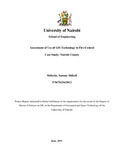| dc.description.abstract | Fire control services are critical services in every society which aim at protecting life and
property. Kenya has experienced fire breakouts in recent years, where property worth millions
of shillings was destroyed and lives were lost. Indeed Urban fire is a menace to property and
human lives, for both the developing and developed countries.
When a fire breaks out, it requires immediate fire control services. Globally, the fire control
system has embraced the use of GIS technology which enhances efficiency in controlling fire
incidents, thus saving lives and preventing destruction of property. GIS is computer software that
links geographic information (where things are) with descriptive information (what things are). It
integrates geographic features with tabular data to assess and better understand real-world
problems.
Fire services in Nairobi County are mainly provided by the County’s Fire Department. To
become competitive and resilience, the County ought to minimize loss of lives and damage to
properties. This study seeks to assess the potential of GIS Technology in enhancing the
efficiency of Fire Control services, in Nairobi County. Ultimately, for more than a decade, GIS
has helped fire departments across the world reduce risk, increase efficiency, and improve
outcomes.
The report uses spatial and non-spatial data having assessed their validity and reliability.
Shapefiles for fire stations, fire hydrants, roads, major hospitals, fire incidents, land uses and
population were used as well as statistics for population, fire stations and incidents were
captured. The Google earth and ArcGIS version 10.2.2 were the main programs that were
applied for the analysis of the data. Through the analysis, the report documents the existing
scenario of fire services and it examines the potential of GIS technology applications.
The report is organized in chapters; the background of the study, the existing situation on fire
control services in Nairobi County, as well as the need for use of GIS program to control fire in
Nairobi County and the research objectives that guided the research are presented in chapter 1.
Chapter 2: looks at the fire response capacity in Nairobi County, the GIS program and its
application in the fire management globally and case studies on how the GIS technology has
underpinned efficiency in provision of fire control services. Chapter 3: defines the study area
upon which it develops research strategies, data collection and analysis and presentation
techniques used. Various research tools, data collection methods and data analysis methods that
are particular to the study are identified. The findings from fieldwork and analysis on data to
establish the need for use of GIS technology in fire control in Nairobi County are outlined in
Chapter 4. Finally, Chapter 5 concludes and outlines recommendations based on the findings and
analysis of the study.
The report concludes that, there is need for the fire department to apply GIS technology in fire
control operations. It recommends that, the GIS technology will have great impact in
ascertaining the location of fire stations, data storage, analysis and assessing the functionality of
fire hydrants. In return this will go a long way in saving lives and loss of property. | en_US |

